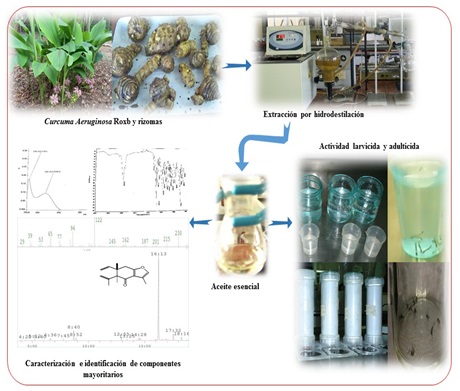Composición química y actividad insecticida frente a mosquitos del aceite esencial de Curcuma aeruginosa Roxb
Palabras clave:
Curcuma aeruginosa; aceite esencial; curzerenona; actividad larvicida; actividad adulticida.Resumen
Con la finalidad de desarrollar alternativas naturales para el control de vectores de importancia médica, fue evaluada la composición química y la actividad insecticida del aceite esencial de rizomas de Curcuma aeruginosa Roxb. El aceite fue caracterizado por sus propiedades organolépticas, físico-químicas y los espectros ultravioleta e infrarrojo. La cuantificación de los componentes del aceite se realizó por cromatografía gaseosa, y fueron identificados los mayoritarios por espectrometría de masas. La Curzerenona resultó el componente más abundante. La actividad insecticida fue evaluada en poblaciones de Aedes aegypti, Aedes albopictus y Culex quinquefasciatus, utilizando metodologías estandarizadas por la Organización Mundial de la Salud. El aceite mantuvo respuesta homogénea frente a las tres poblaciones de mosquitos, mostrando una significativa actividad larvicida y adulticida. Constituye el primer reporte de la composición química del aceite esencial de C. aeruginosa cultivada en la región oriental cubana, y los bioensayos demostraron su potencial insecticida como alternativa ecológica.
Citas
MARÍN, R. M., et al. “Estudio químico y potencialidades biológicas de especies vegetales que crecen en Cuba”. Anales de la Academia de Ciencias de Cuba. 2020; 11 (1): 901. ISSN: 2304-0106.
AHMED, R. H.; MUSTAFA, D. E.; MOHAMED, Y. S. “Anti-diabetic Plants used in Sudanese Folk Medicine and their Phytochemical Constituents”. Journal of Advanced Research in Pharmaceutical Sciences & Pharmacology Interventions. 2019, 3 (1): 3-6. ISSN:2455-6998.
HARTATI, F. K.; KURNIA, D.; NAFISAH, W.; HARYANTO, I. B. “Potential anticancer agents of Curcuma aeruginosa-based kombucha: In vitro and in silico study”. Food Chemistry Advances. 2024, 4, 100606. https://doi.org/10.1016/j.focha.2024.100606
YUANDANI et al. “Antibacterial, bacteriolytic, antibiofilm, and synergistic effects of Curcuma species ethanol extracts with antibiotic against multidrug resistant Pseudomonas aeruginosa”. J. Herbmed. Pharmacol. 2024; 13 (1): 153-162. https://doi.org:10.34172/jhp.2024.48295
AKARCHARIYA, N.; SIRILUN, S.; JULSRIGIVAL, J.; CHANSAKAOWA, S. “Chemical profiling and antimicrobial activity of essential oil from Curcuma aeruginosa Roxb., Curcuma glans K. Larsen & J. Mood and Curcuma cf. xanthorrhiza Roxb. collected in Thailand”. Asian. Pac. J. Trop. Biomed. 2017, 7 (10): 881-885. ISSN: 2588-9222.
RAHAMAN, M. M. et al. “The Genus Curcuma and Inflammation: Overview of the Pharmacological Perspectives”. Plants. 2021, 10(63): 2-19 https://doi.org/10.3390/plants10010063
ALI, A.; WANG, Y. H.; KHAN, I. “Larvicidal and biting deterrent activity of essential oils of Curcuma longa, Ar-turmerone, and Curcuminoids against Aedes aegypti and Anopheles quadrimaculatus (Culicidae: Diptera)”. J. Med. Entomol. 2015, 52 (5): 979–986. https://doi.org/10.1093/jme/tjv072
LEYVA, M. et al. “Plantas con actividad insecticida: una alternativa natural contra mosquitos. Estado actual de la temática en la región de las Américas”. Rev. Biomed. 2017, 28: 139-181. https://doi.org/10.32776/revbiomed.v28i3.571
ANDRADE-OCHOA S. et al. “Aceites esenciales y sus componentes como una alternativa en el control de mosquitos vectores de enfermedades”. Biomédica. 2017, 37 (Supl.2): 224-43. https://doi.org/10.7705/biomedica.v34i2.3475
DOSOKY, N. S. y SETZER, W. N. “Chemical Composition and Biological Activities of Essential Oils of Curcuma Species”. Nutrients. 2018; 10: 1196. ISSN 2072-6643.
ELHAWARY, E. A.; MOUSSA, A. Y; SINGAB, A. N. “Genus Curcuma: chemical and ethnopharmacological role in aging process”. BMC Complementary Medicine and Therapies. 2024, 24:31. https://doi.org/10.1186/s12906-023-04317-w
MINSAP. Medicamentos de origen vegetal: Droga cruda. Métodos de ensayos. NRSP 309. La Habana, 1991.
MINSAP. Medicamentos de origen vegetal. Extractos fluidos y tinturas. Métodos de ensayo. NRSP 312. La Habana, 1992
WHO. Guidelines for laboratory and field testing of mosquito larvicides. WHO/CDS/WHOPES/GCDPP/Ginebra,2005.13. Disponible en: https://www.who.int/publications/i/item/WHO-CDS-WHOPES-GCDPP-2005.13
CDC. Centers for Disease Control and Prevention (2010). Guideline for Evaluating Insecticide Resistance in arthropods vectors using the CDC bottle bioassay. Atlanta, GA. Disponible en: https://www.cdc.gov/malaria/resources/pdf/fsp/ir_manual/ir_cdc_bioas-say_en.pdf
ORGANIZACIÓN MUNDIAL DE LA SALUD. Prueba OMS de susceptibilidad para mosquitos adultos. En: Procedimientos de las pruebas para la vigilancia de la resistencia a los insecticidas en los mosquitos vectores del paludismo. 2da Ed. OMS Press. Ginebra, Suiza. 2017. ISBN 978-92-4-351157-3
OANH, P. T. et al. “The rhizome essential oil of Curcuma aeruginosa Roxb. (Zingiberaceae) from Vietnam”. Trends Phytochem. Res. 2018, 2 (3):179–84. ISSN: 2588-3631.
ARIAS CEDEÑO, Q. et al. “Characterization of the Curcuma longa L. essential oil and its insecticidal activity against Aedes aegypti”. Revista Cubana de Química, 2020; 32 (3), 378-389. e-ISSN: 2224-5421.
BARRADAS, T. N.; DE HOLANDA E SILVA, K. G. “Nanoemulsions of essential oils to improve solubility, stability and permeability: a review”. Environ. Chem. Lett. 2021, 19: 1153–1171. https://doi.org/10.1007/s10311-020-01142-2
CHÁVEZ FERNÁNDEZ, J.; LIZÁRRAGA LAZO, V.; VARGAS DE NIETO, E. “Caracterización físico química de los componentes volátiles del Tecoma fulva subsp. Arequipensis (cahuato)”. Rev. Soc. Quím. Perú. 2020, 86(3), 246-259 Disponible en: http://www.scielo.org.pe/pdf/rsqp/v86n3/2309-8740-rsqp-86-03-246.pdf
THEANPHONG, O.; MINGVANISH, W.; KIRDMANEE, C. “Chemical constituents and biological activities of essential oil from Curcuma aeruginosa Roxb. Rhizome. BHST. 2015, 13 (1), 06-16. ISSN: 0858-7531.
LEYVA-SILVA, M. I. Actividad insecticida de aceites esenciales sobre vectores de importancia médica Aedes aegypti, Aedes albopictus y Culex quinquefasciatus (Diptera: Culicidae). La Habana 2012-2017. Tesis de doctorado en Ciencias de la Salud. Instituto de Medicina Tropical “Pedro Kourí”, La Habana, 2019. [Fecha de consulta: 3 diciembre 2023] Disponible en: https://tesis.sld.cu/index.php/index.php?P=FullRecord&ID=85
ZHENG, T. et al. “Anticancer effects of curzerenone against drug-resistant human lung carcinoma cells are mediated via programmed cell death, loss of mitochondrial membrane potential, ROS, and blocking the ERK/MAPK and NF-κB signaling pathway” JBUON. 2019, 24 (3): 907-912. ISSN: 1107-0625
LIM, H.; LEE, S. Y.; HO, L. Y.; SIT, N. W. “Mosquito Larvicidal Activity and Cytotoxicity of the Extracts of Aromatic Plants from Malaysia”. Insects. 2023, 14: 512-530. Disponible en: https://www.mdpi.com/2075-4450/14/6/512
AUNGTIKUN, J. y SOONWERA, M. “Improved adulticidal activity against Aedes aegypti (L.) and Aedes albopictus (Skuse) from synergy between Cinnamomum spp. essential oils”. Scientific. Reports. 2021, 11: 4685-4697. https://doi.org/10.1038/s41598-021-84159-z

Descargas
Publicado
Cómo citar
Número
Sección
Licencia
Derechos de autor 2024 Quirino Arias-Cedeño, Maureen Leyva-Silva, Pedro L. Guevara-Blanco, Lázaro E. Valdés-Izaguirre, Peter- Langer

Esta obra está bajo una licencia internacional Creative Commons Atribución-NoComercial-SinDerivadas 4.0.
Esta revista proporciona un acceso abierto inmediato a su contenido, basado en el principio de que ofrecer al público un acceso libre a las investigaciones ayuda a un mayor intercambio global de conocimiento. Cada autor es responsable del contenido de cada uno de sus artículos.






















